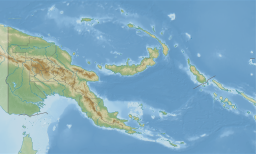|
Bismarck Sea
The Bismarck Sea (German: Bismarcksee, pronounced ['bɪsmarkzeː]) lies in the south-western Pacific Ocean within the Papua New Guinean exclusive economic zone.[1][2] It is located north-east of the island of New Guinea and south of the Bismarck Archipelago. It has coastlines in districts of the Islands Region, Momase Region, and Papua Region. GeographyLike the Bismarck Archipelago, it is named in honour of the first German Chancellor Otto von Bismarck.[a] The Bismarck Archipelago extends round to the east and north of the sea, enclosing the Bismarck Sea and separating it from the Southern Pacific Ocean. To the south it is linked to the Solomon Sea by the Vitiaz Strait.[4] Official boundaries The International Hydrographic Organization defines the Bismarck Sea as "that area of the South Pacific Ocean off the northeast coast of New Guinea", with the following limits:[5]
GeologyThe geology is related to the tectonic processes that have produced the underlying South Bismarck Plate and the relic North Bismarck Plate.[6] These processes have created the Melanesian arc volcanoes and explain the many earthquakes under the sea.[6] Mineral wealthRecent explorations in the Bismarck Sea seabed have yielded discoveries of mineral-rich beds of sulfides, copper, zinc, silver and gold. These findings are especially important because they lie in shallow, calm waters. Papua New Guinea owns the mining rights to these minerals under international law.[7] Important Bird AreaSome 5,200 km2 of the Bismarck Sea, between the north-eastern end of New Britain and New Ireland, has been recognised as an Important Bird Area (IBA) by BirdLife International because it apparently supports a population of Beck's petrels, following sightings at sea of this rare and enigmatic species, of which the breeding grounds remain undiscovered.[8] HistoryIt was the site of a major Japanese naval defeat in the Battle of the Bismarck Sea during World War II on 3 and 4 March 1943.[9] See alsoNotes
References
External links |
||||||||||||||||||||||||||

